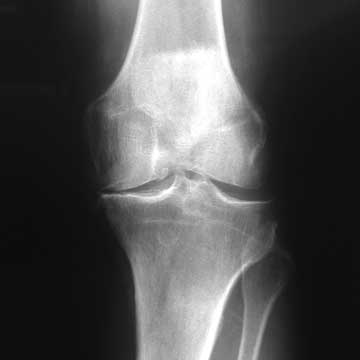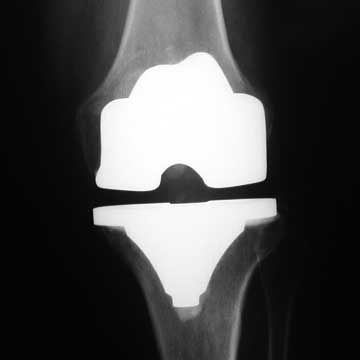|


|
synonyms: knee osteoarthritis, Knee OA, knee degenerative joint disease, knee DJD
Knee Arthritis ICD-10
Knee Arthritis ICD-9
- 715.16 (primary osteoarthritis lower leg)
- 715.26 (secondary osteoarthritis lower leg)
- 714.0 (rheumatoid arthritis)
- 714.30 (juvenile rheumatoid arthritis)
- 905.4 (late effect of injury / fracture)
Knee Arthritis Etiology / Epidemiology / Natural History
- 120,000 per year, $25,000 each
- By age 40, 90% of persons have some degenerative changes in their weight bearing joints
- When minimal disease is excluded, the prevelance is @ 20%.
- Risk Factors: Obesity (Felson DT, Ann Intern Med 1988;109:18) (Davis MA, J Rheumatol 1988 Dec;15:1827); Major injury; Repetitive use, such as in jobs requiring heavy labor and knee bending, probably increases the risk of knee osteoarthritis. (Felson DT, Epidemiol Rev 1988;10:1; Prior menisectomy
- More common in females than males.
Knee Arthritis Anatomy
- Mechanical axis of the lower extremity=line drawn from center of femoral head to center of ankle joint, should pass through center of knee. Mechanical axis of the femur = line drawn from center of femoral head to center of the femoral surface of the knee. Mechanical axis of the tibia = line from the center of the tibial plateau to the center of the ankle.
- Anatomic axis=line drawn down center of tibial or femur.
- Tibiofemoral angle=angle between tibial and femoral anatomic axis. Normal = 6° valgus.
- Deformity can be defined as the angle drawn between the mechanical axis of the femur (i.e., the middle of the femoral head to the middle of the femoral surface of the knee) and the mechanical axis of the tibia. or as the deformity defined by the tibiofemoral angle, or the angle created between the anatomic axes of the femur and tibia.
- Medial plateau is larger and concave, lateral plateau is smaller and convex
- Epicondylar axis is @3 degrees externally rotated as compared to posterior condylar line
- Distal femoral condyles are in 9 valgus relative to femoral anatomic axis
- Tibial plateau is in 3 varus relative to tibial axis
- Tibial plateau has @10 posterior slope
- 3 compartments =medial, lateral, patellofemoral
- Medial femoral circumflex artery supplies the femoral head. (anterior humeral circumflex supplies humeral head)
Knee Arthritis Clinical Evaluation
- Complain of pain and difficulty walking, climbing stairs and arising from seated position. Must assess impact of knee pain on quality of life / ADL's.
- Always discuss metal allergy.
- Assess Q-angle (formed by a line between the patella center extending proximally to the anterosuperior iliac spine and distally to the tibial tubercle; normal Q angle is less than 10 degrees in men and less than 15 degrees in women.)
Knee Arthritis Xray / Diagnositc Tests
- Weight bearing A/P long leg films: marginal osteophytes, tibial and patellar spurring, subchondral sclerosis, joint space narrowing, flattening, squaring of the condyles and joint line angulation.
- Weight-bearing lateral in extension
- Flexion lateral
- Merchants view(Merchant, JBJS, 1974)
- Flexion weight bearing (Rosenburg JBJS, 1988)
Knee Arthritis Classification / Treatment
- Kellgren and Lawrence scale
-
- Grade 0 = no significant changes
- Grade 1 = minute osteophyte
- Grade 2 = definite osteophyte
- Grade 3 = diminution joint
- Grade 4 = impaired joint space
Knee Arthritis Non-operative treatment
- Activity modification
- Exercise: low-impact excercise including isokinetic and isotonic strengthening improves symptoms, function and cartilge glycosaminoglycan content. (Roddy E, Rheumatology 2005;44:67).
- Cane/walker (Blount WP, JBJS 1956;38A:695).
- NSAIDs: diclofenac 150 mg/day is the most effective NSAID available at present, in terms of improving both pain and function. (da Costa Bruno R, The Lancet, Published Online: 17 March 2016). Acetaminophen is ineffective for hip and knee arthritis. May consider Diclofenac Sodium 1.5% topical (Pennsaid).
- Glucosamine sulfate / Chondroitin Sulfate
- Corticosteriod injections
- Viscosupplementation (Hyaluronic acid injections): Can provide up to 6 months of improvement. (Arrich J CMAJ 2005;172:1039). Side effects: injection site pain, pseudoseptic reaction, infection.
- Weight loss: reduces risk of OA progression and improves symptoms and function (Messier SP, Arthritis Rheum 2004;50:1501).
- Platelet-rich plasma injection. (Sánchez M, Clin Exp Rheumatol 2008; 26:910).
Knee Arthritis Surgical Options
- Arthroscopic debridement-indicated for pt with ,1yr symptoms, nl alignment, mechanical symptoms.
- Unicompartmental knee- indications flexion cont <15, ROM >90, age >60, sedentary: rehab easier, costs less, quicker ROM, preserves ligamants/proprioception, 92% last 10yr, 15yrs = 60% working. Creates bone defect which often must be filed with allograft
- High Tibial Osteotomy-for varus deformity <15, young pt, vigorous lifestyle, isolated medial arthritis, obese, ROM>90, flexion contracture<15. Need full length weight bearing radiographs. comps=under/overcorrection, AVN, patella baja, peroneal N. injuries, anterior compartment syndrome. Lasts 7-10 yrs. Osteotomy contraindicated in inflammatory arthropathy.
- Distal femoral osteotomy-for valgus deformity <15, indications as above
- Arthodesis-indicated for infection, failed TKA, young active patients, soft tissue defects, absent extensor mechanism, neuropathic joint disease. fusion in 10-15 flexion and 0-7 valgus. complications=infection, non/malunion, pain.successful in 80-90% of failed condylar components, 55% of failed hinged prosthesis.
- Total Knee Arthroplasty
Knee Arthritis Associated Injuries / Differential Diagnosis
TKA Complications
- Death: 0.53%
- Periprosthetic Infection: 0.71%
- Pulmonary emboli: 0.41%
- Patella fracture:
- Component Loosening:
- Tibial tray wear:
- Peroneal Nerve Palsy: 0.3% to 2%
- Periprosthetic Femur Fracture:
- Periprosthetic Tibial Fracture:
- Wound Complications / Skin slough: rare
- Patellar Clunk Syndrome: rare
- Patellofemoral Instability: 0.5%-29%
- DVT:
- Instability:
- Popliteal artery injury: 0.05%
- Quadriceps Tendon Rupture: 0.1%
- Patellar Tendon Rupture: <2%
- Stiffness:
- Fat Embolism
TKA Follow-up Care
Knee Arthritis Review References
- Fu FH, Management of Osteoarthritis of the Knee: An INternaltional Consensus, AAOS Monograph, 2003
|


